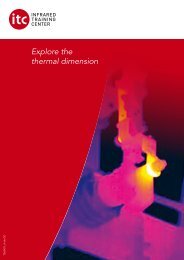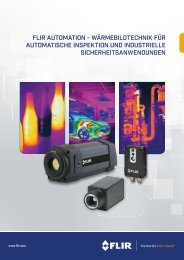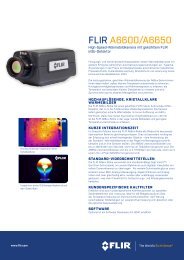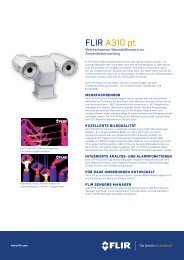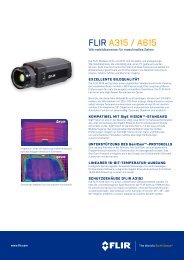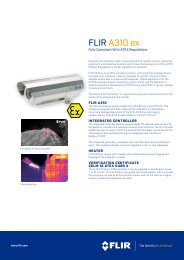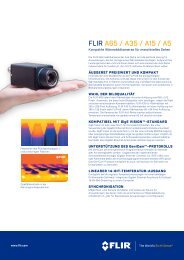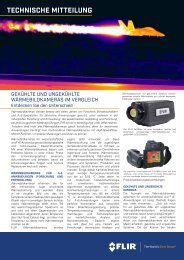Booklet Forschung und Entwicklung EN
Create successful ePaper yourself
Turn your PDF publications into a flip-book with our unique Google optimized e-Paper software.
Filters Extend IR Camera Usefulness<br />
Different types of filter characteristics<br />
100<br />
90<br />
80<br />
70<br />
60<br />
50<br />
40<br />
30<br />
System response curve<br />
Long-pass filter<br />
Band-pass filter<br />
Narrow band-pass filter<br />
Short-pass filter<br />
20<br />
10<br />
0<br />
1.5 2 2.5 3 3.5 4 4.5 5 5.5<br />
Wavelength, µm<br />
Figure 2. Response curves for different types of filters<br />
specified with a center wavelength and<br />
a half-width (half-power) wavelength,<br />
the latter being the width where spectral<br />
response has decreased to 50% of its<br />
maximum.<br />
For temperature measurements on<br />
transparent materials, the filter selected<br />
must provide a band of essentially<br />
complete absorption. Incomplete<br />
absorption can be used, at least<br />
theoretically, provided that both<br />
absorptance and reflectance are known<br />
and stable at the absorption band.<br />
Unfortunately, absorption often varies with<br />
both temperature and thickness of the<br />
material.<br />
An example of applying a NBP filter to<br />
the measurement of polyethylene film<br />
temperature is shown in Figure 3. The blue<br />
curve in the figure shows the absorption<br />
band of polyethylene film. The red curve<br />
shows the transmittance of a 3.45µm<br />
NBP filter, which is designed to match<br />
polyethylene film. The green curve shows<br />
the resulting transmission through film<br />
plus the filter. This curve, running just<br />
above the zero line, indicates an excellent<br />
filter adaptation, i.e. the film appears to be<br />
opaque to the camera, and no backgro<strong>und</strong><br />
radiation would disturb the measurement<br />
of film temperature.<br />
Filters can also be classified according to<br />
their application temperature. Traditionally,<br />
cold filters, filters that are stabilized at or<br />
near the same temperature as the detector,<br />
are the most accurate and desired filters<br />
for thermal signatures. Warm filters, filters<br />
screwed onto the back of the optical lens<br />
outside of the detector/cooler assembly, are<br />
also commonly used but tend to provide<br />
more radiometric calibration uncertainty<br />
due to varying IR emission with ambient<br />
temperature changes.<br />
27





